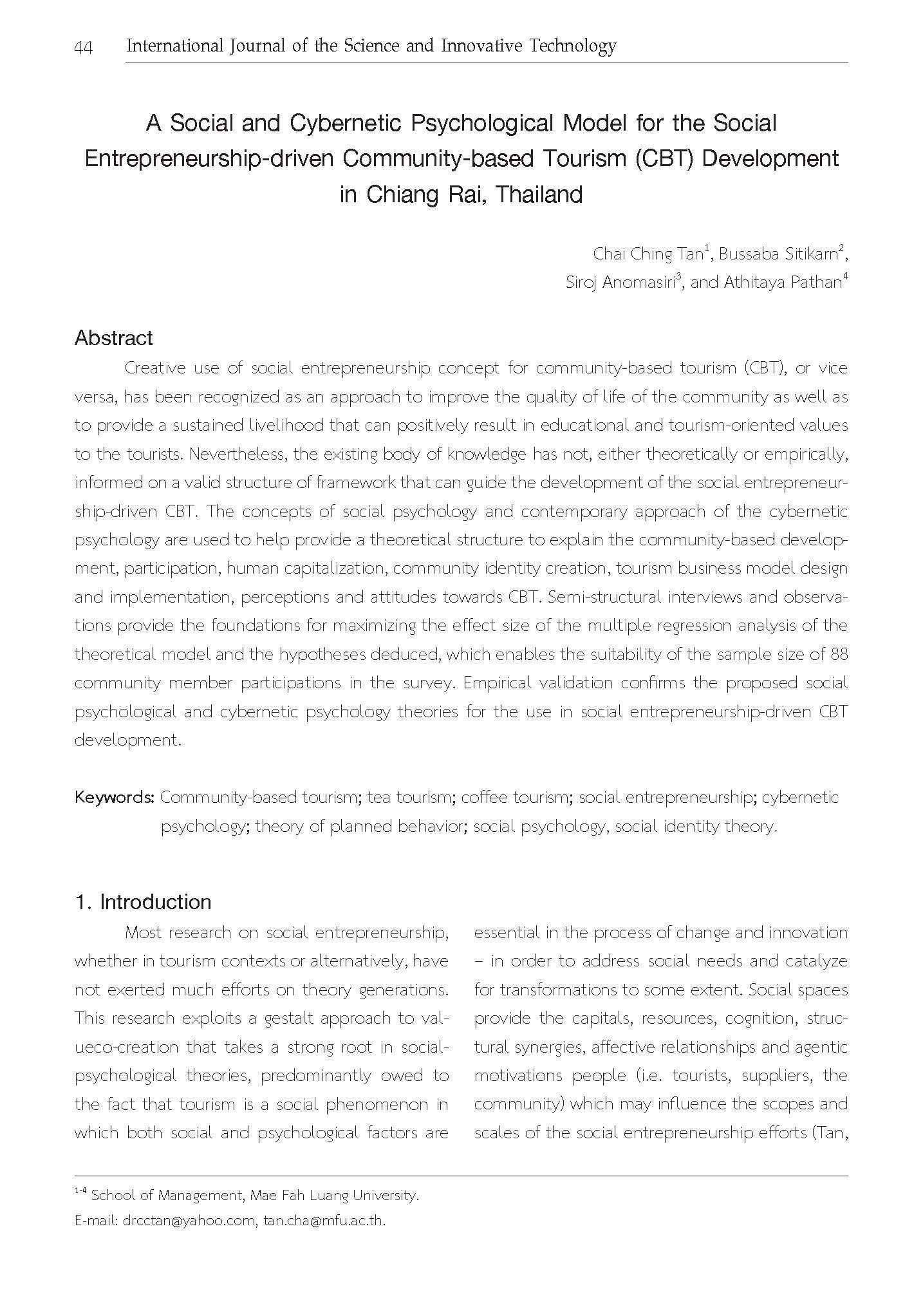A Social and Cybernetic Psychological Model for the Social Entrepreneurship-driven Community-based Tourism (CBT) Development in Chiang Rai, Thailand
Main Article Content
Abstract
Creative use of social entrepreneurship concept for community-based tourism (CBT), or vice
versa, has been recognized as an approach to improve the quality of life of the community as well as
to provide a sustained livelihood that can positively result in educational and tourism-oriented values
to the tourists. Nevertheless, the existing body of knowledge has not, either theoretically or empirically,
informed on a valid structure of framework that can guide the development of the social entrepreneurship-
driven CBT. The concepts of social psychology and contemporary approach of the cybernetic
psychology are used to help provide a theoretical structure to explain the community-based development,
participation, human capitalization, community identity creation, tourism business model design
and implementation, perceptions and attitudes towards CBT. Semi-structural interviews and observations
provide the foundations for maximizing the effect size of the multiple regression analysis of the
theoretical model and the hypotheses deduced, which enables the suitability of the sample size of 88
community member participations in the survey. Empirical validation confirms the proposed social
psychological and cybernetic psychology theories for the use in social entrepreneurship-driven CBT
development.
Article Details
References
Smiling at Me? Schema Congruity as a Basis for
Evaluating Antropomorhized Products. Journal of Consumer Research, 34(4): 468-479.
2. Ajzen, I. (1991). The theory of planned behavior.
Organizational Behavior and Human Decision Processes, 50: 179-211.
3. Ajzen, I. and Fishbein, M. (1980). Understanding
attitudes and predicting social behavior. Englewood Cliffs, NJ: Prentice-Hall.
4. Ajzen, I. and Madden, T.J. (1986). Prediction of
goal-directed behavior: Attitudes, intentions, and
perceived behavioral control. Journal of Experimental
Social Psychology, 22: 453-474.
5. Argyris, C., & Schon, D.A. (1978). Organizational
learning: A theory of action perspective. Reading, MA: Addison Wesley.
6. Balogun, J., & Floyd, S.W. (2010). Breaking out of
strategy vectors: Reintroducing culture. Research
in Organizational Change and Development, 18: 51-76.
7. Belk, R.W. (1988). Possession and the extended
self. Journal of Consumer Research, 15(2): 139-168.
8. Bourner, T. (2011). Action learning over time: An
Ipsative enquiry. Action Learning: Research and
Practice, 8(1), pp. 3-56.
9. Casteran, H., & Roederer, C. (2013). Does authenticity
really affect behavior? The case of the Strabourg
Christmas market. Tourism Management, 36: 153-163.
10. Coghlan, D., & Rigg, C. (2012). Action learning as
praxis learning and changing. Research in Organizational
Change and Development, 20: 69-89.
11. Darley, J.M., & Latane, B. (1968). Bystander intervention
in emergencies: Diffusion of responsibility.
Journal of Personality and Social Psychology, 8: 377-383.
12. Dawes, P.L. (2003). A model of the effects of
technical consultants on organizational learning
in high-technology purchase situations. The Journal
of High Technology Management Research, 14: 1-20.
13. Drucker, P.F. (1985). Innovation and entrepreneurship.
New York: Harper Business.
14. Garcia, S.M., Weaver, K., Moskowtiz, G.B., & Darley,
J.M. (2011). Crowded minds: The implicit bystander
effect. In R.J. Crisp (Ed.), Social Psychology: Critical
Concepts in Psychology: 153-178. New York, NY: Routledge.
15. Hawken, P., Lovins, A., & Lovins, L. (2008). Natural
capitalism: Creating the next industrial revolution.
Boston: Back Bay Books.
16. Herrera, M.E.B. (2015). Creating competitive
advantage by institutionalizing corporate social
innovation. Journal of Business Research, 68: 1468-1474.
17. Inkpen, A., & Currall, S. (2004). The coevolution
of Trust, Control and Learning in Joint Ventures.
Organization Science, 15: 586-599.
18. Inta, A., Shengji, P., Balslev, H., Wangpakapattanawong,
P., & Trisonthi, C. (2008). A comparative
study on medicinal plants used in Akha’s traditional
medicine in China and Thailand, cultural coherence
or ecological divergence. Journal of Ethnopharmacology, 116: 508-517.
19. Kickul, J., & Bacq, S. (2012). Patterns in social
entrepreneurship research. Massachusetts:
Edward Elgar Publishing, Inc.
20. Kunjuraman, V., Hussin, R., & Yasir, S.M. (2015).
Challenges of seaweed community-based homestay
programme in Sabah, Malaysian Borneo. Proceedings
of the Hospitality & Tourism Conference 2015.
London: Taylor & Francis Group.
21. Mandler, B. (1975). Mind and emotion. New York: Wiley.
22. Marquardt, M. (2002). Building the learning
organization. USA: Davis-Black Publishing.
23. Martin, R.L., & Osberg, S. (2007). Social entrepreneurship:
The case for definition. Stanford Social Innovation Review, 5(2): 28-39.
24. Morgan, D.E., & Zeffane, R. (2003). Employee
involvement, organizational change and trust in
management. International Journal of Human
Resource Management, 42(4): 403-419.
25. Nonaka, I., & Takeuchi, H. (1995). The knowledgecreating
company: How Japanese companies
create the dynamics of innovation. New York: Oxford University Press.
26. Perrini, F., & Vurro, C. (2012). A multi-stakeholder
perspective on social business planning: Opportunity
discovery and exploitation in the case of
dynamo camp. In J. Kickul and S. Bacq (Eds.),
Patterns in Social Entrepreneurship Research:
42-67. Massachusetts: Edward Elgar Publishing Limited.
27. Piderit, S.K. (2000). Rethinking resistance and
recognizing ambivalence: A multidimensional
view of attitudes toward an organizational change.
Academy of Management Review, 25(4): 783-794.
28. Pryor, J.B., & Ostrom, T.M. (1981). The cognitive
organization of social information: A convergingoperations
approach. Journal of Personality and
Social Psychology, 41: 628-641.
29. Schianetz, K., Kavanagh, L., & Lockington, D. (2007).
The learning tourism destination: The potential
of a learning organization approach for improving
the sustainability of tourism destinations. Tourism
Management, 28: 1485-1496.
30. Tan, C.C. (2016). Towards a phenomenological
theory of corporate social responsibility and its
spirited services. India: IMRF Publication House.
ISBN 978-93-84124-99-1.
31. Wiener, N. (1948). Cybernetics or control and
communication in the animal and the machine.
Boston, Massachusetts: M.I.T. Press.
32. Worley, C.G., & Lawler, E.E. III. (2010). Built to
change organizations and responsible progress:
Twin pillars of sustainable success. Research in
Organizational Change and Development, 18: 1-49.
33. Yolles, M., Fink, G., & Dauber, D. (2011). Organizations
as emergent normative personalities: Part
1. The concepts. Kybernetes, 40(516): 635-669.
34. Yolles, M., & Gerhard, F. (2014). Personality,
pathology, and mindsets: Part 1 – Agency,
personality and mindscapes. Kybernetes, 43(1): 92-112.
35. Zahra, S.A., Gedajlovic, E., Neubaum, D.O., &
Shulman, J.M. (2009). A typology of social entrepreneurs:
Motives, search processes and ethical
challenges. Journal of Business Venturing, 24(5):
519-532 Acknowledgement The authors would
like to acknowledge the


